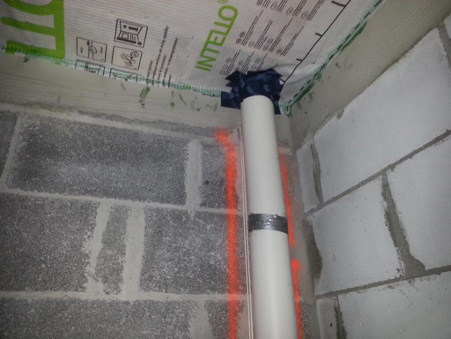
Air Tightness
With more strict building regulations requiring better energy efficiency, air tightness in buildings has become increasingly important in recent years. Architects, builders and self-build homeowners are now aware that air tightness, which is the effective eradication of natural leaks and draughts in a home, is the first important step in creating a low energy home.
The aim should be to ‘build tight – ventilate right’. Buildings that are built “airtight” will require some form of mechanical ventilation. We have a blog which discusses the various form of ventilation systems available to homeowners when constructing a new home.
When calculating the heat loss for a building, the two elements that have the highest energy loss is air leakage and glazing, as glazing has a higher U-value than the other fabric elements in the home. It is pointless investing a lot of money on triple glazed windows if they are not fitted correctly with airtight tapes and seals to prevent air leakage where they join onto the block.
The type of build structure you choose can impact the level of air tightness you can achieve. For example, it is possible to obtain a reasonably accurate air permeability rating for a timber frame built home from the contractor. It is harder to achieve a good air tightness rating in block-built houses, but it is still possible with attention to detail. However, whichever type of building structure you choose, sourcing a main contractor who believes in the importance of air tightness measures will ensure your new house is set up to enable the heating system to perform to its maximum efficiency.
The earlier we get involved the more impact we can make to achieving a low energy home. However if your build has progressed without these measures being high on the list of priorities, we can still advise you on how to achieve optimum air tightness and conduct air tightness tests.
The list below will give you an idea of typical air leakage paths in a private dwelling:
-
- Around Window and Door Frames
- Around light fittings and electrical sockets
- At first floor ceiling level
- Where first floor slab meet cavity walls
- Where services such as pipes and cables penetrate the building
 Image of Air Tight Membrane fitted to first floor ceiling, and airtight tape sealing ventilation pipe penetrating ceiling
Image of Air Tight Membrane fitted to first floor ceiling, and airtight tape sealing ventilation pipe penetrating ceilingIt is also possible to obtain good air-tightness in retrofit projects. Our first step when undertaking retrofit projects is to carry out a thermal imaging survey. The aim of the survey is to ensure the building fabric is reasonably well insulated to enable a renewable heating system such as a ground or air source heat pump to work to its maximum potential.
To discuss Air Tightness on your project why not give us a call?






